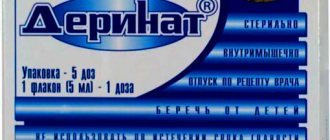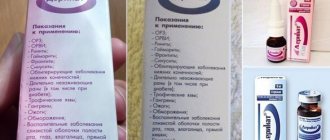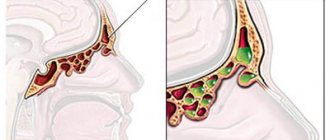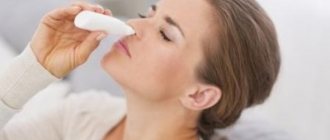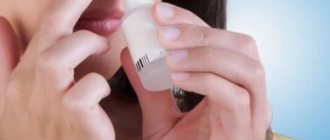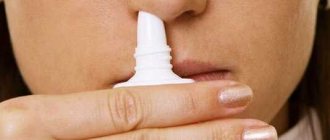What is phenylephrine
Phenylephrine (mesaton) is a substance of organic origin and synthesized artificially, belongs to the category of alpha adrenergic agonists. The component is included in the content of various medications, and is produced in the form of solutions for intramuscular and intravenous injections, ointments, tablets, suspensions, drops in the eyes and nose, as well as rectal suppositories.
Acting on alpha-adrenergic receptors, the compound narrows the capillaries, resulting in an increase in blood pressure. This property allows it to be used to treat certain diseases of the organs of vision, hypotension, and also as an analogue of adrenaline. In addition, the substance is a component of some rectal suppositories and is used for diseases of the rectum.
Mezaton, together with other ingredients, is included in many oral medications that are prescribed for the treatment of adults and children.
One of the main areas of use of phenylephrine is the treatment of the upper respiratory organs, in particular laryngitis, pharyngitis, tonsillitis and some viral infections.
Rhinitis, characteristic of many infectious and inflammatory pathologies, is accompanied by severe swelling of the mucous membrane and increased sputum synthesis. Drops with phenylephrine, when used topically, have a pronounced vasoconstrictor effect, relieve swelling and suppress acute inflammation, which leads to a decrease in mucous secretion in the nasal tract and the restoration of full breathing.
Medicines based on mesaton can also be used in the treatment of allergic and vasomotor rhinitis.
When should the drug not be used?
Before starting treatment, you should pay attention to the fact that Adrianol nasal drops for children, according to the instructions, are prohibited from being used until the child reaches 3 years of age. The medicine is not suitable for the following categories of young patients:
- having an allergy to any of its components;
- those suffering from kidney and liver diseases;
- those who have persistently high blood pressure;
- children who have atrophy of the nasal mucosa;
- children with ischemic heart disease, atherosclerosis, thyrotoxicosis.
Indications for use
Preparations containing phenylephrine are indicated for rhinitis of various origins, which may accompany the following diseases:
- viral infections;
- colds, flu;
- allergic rhinitis;
- sinusitis;
- inflammation of the middle ear.
Mezaton belongs to the group of short-acting vasoconstrictors: its effect lasts about 4 hours. This allows it to be used in pediatrics, as well as for the treatment of pregnant women, but only under the supervision of the attending physician.
Phenylephrine is a symptomatic substance that helps alleviate the condition for a certain period of time. However, as an independent remedy it does not have a therapeutic effect.
Most often, the substance is combined with other medications as part of a complex treatment. One of the effective combination remedies is Polydex spray, which affects not only the symptoms, but also the cause of the runny nose.
When will Adrianol's help come in handy?
What are Adrianol drops used for? They are indicated for acute and chronic runny nose and sinusitis. That is, this tool can be useful in such cases:
- if the child has a very stuffy nose;
- if there is intense secretion of mucus from the nose in parallel with the development of other ENT pathologies;
- if your runny nose is caused by an allergy to any irritants;
- with insufficient outflow of mucous secretions;
- if rhinitis is caused by a viral disease (it is recommended to use drops at the first symptoms of infection).
Contraindications and negative consequences
Phenylephrine nasal drops have certain limitations for use. These include:
- intolerance to the active substance;
- cardiac disorders, including angina pectoris and ischemia;
- cerebral aneurysm;
- diabetes mellitus, increased thyroid function;
- inflammation of the nasal passages, not accompanied by mucous secretion (“dry rhinitis”)
- severe kidney disease;
- glaucoma.
According to the instructions for use, drugs based on mezaton can provoke the following negative effects:
- nausea, vomiting;
- pain in the head, dizziness;
- prostration;
- sleep disturbance;
- soreness in the heart area;
- cardiac dysfunction, tachycardia, bradycardia;
- Among the local negative consequences are dry mucous membranes, as well as unpleasant sensations in the form of burning and tingling.
In addition, uncontrolled use of the substance can lead to allergic reactions, psychomotor agitation, and increased irritability.
Antiviral
If the cause of rhinitis is a respiratory viral infection, antiviral medications may be prescribed. Many products are available in the form of drops. These include:
- "Interferon";
- "Grippferon";
- "Aminocaproic acid" (solution for infusion).
Nasal medications act directly on viruses: they suppress the ability to reproduce. Additionally, such drops activate the child’s immunity, promoting faster recovery. By the way, “Aminocaproic acid” is not available in the form of nasal drops. This remedy is widely used in surgical medicine, but its effectiveness has been proven in the treatment of heavy nasal discharge. Also, “Aminocaproic acid” is considered an effective prophylactic against influenza and ARVI viruses.
Rules for using funds
Infectious and inflammatory pathologies of the upper respiratory organs, as a rule, are treated comprehensively, with nasal drops and aerosols used as local therapy. Phenylephrine, like other vasoconstrictors, is used in conjunction with other medications, thereby achieving a therapeutic effect.
Rhinitis and sinusitis of allergic origin should not be treated independently . These diseases require a competent medical approach. To treat allergic reactions, in addition to taking antihistamines, it is necessary to ensure vasoconstriction and relieve swelling. Phenylephrine, contained in some nasal preparations, has a mild, gentle effect on the inner surfaces of the nose.
Nasal drops and sprays containing mesaton must be used as prescribed by a specialist. The duration of their use should not be more than 3-5 days, otherwise there is a possibility of disruption of the mucous membrane, development of addiction and medicinal rhinitis.
The therapeutic effect of the drugs begins one to two minutes after administration and lasts for 3-4 hours. Before use, clear the nasal passages of mucus using salt-based solutions. A single dose is 1-3 drops, which should be instilled no more than 4 times a day.
Therapeutic effect
Phenylephrine eye drops belong to the group of adrenergic agonists. When instilled, they act directly on nerve endings and α-receptors in the cornea. In response, vasoconstriction occurs, increasing intraocular pressure. At the same time, changes occur gradually without sudden jumps, and therefore do not cause unpleasant sensations.
Among the therapeutic effects of Phenylephrine drops:
- reduction of burning and itching;
- removal of swelling;
- normalization of the lacrimal canal;
- reduction of pain due to inflammation.
The effect lasts from 2 to 7 hours, allowing for a comprehensive examination or treatment. Additionally, the tone of the capillaries increases, which stimulates the flow of oxygen, blood and nutritional components to the tissues, improving their condition.
The active substances contained in Phenylephrine drops penetrate the body’s circulatory system. They gradually concentrate in the human liver, where they are purified and metabolized. The medicine is completely eliminated by the intestines after 12–24 hours.
Name of products containing phenylephrine
All phenylephrine-based medications must be used strictly on the recommendation of the attending physician and in accordance with the instructions. Self-medication, especially in childhood, can provoke unpleasant consequences.
Polydexa
One of the most popular and effective medications based on mesatone is Polydex, which is produced in the form of a spray. The medicine has a combined composition: in addition to the main component, the contents include neomycin, polymyxin, and dexamethasone.
Neomycin is an antibiotic that exhibits therapeutic activity against bacteria, in particular staphylococci, pneumococci, and Pseudomonas aeruginosa. Polymyxin successfully suppresses the proliferation of Klebsiella, Escherichia and other pathogenic microbes that can cause purulent processes. Dexamethasone is a hormonal component that has an intense anti-inflammatory and anti-edematous effect.
The combination of active components causes the pronounced vasoconstrictor, antibacterial and anti-inflammatory effects of Polydexa. The medication is prescribed for the treatment of:
- rhinorrhea;
- runny nose of various etiologies, including purulent ones;
- sinusitis, sinusitis;
- adenoiditis;
- for the purpose of prevention after surgical intervention on the nasal cavity.
The medicine is indicated for the treatment of adults and children over two and a half years of age.
Adults are prescribed one irrigation in each nostril 3 to 5 times a day. Children under 12 years of age use three injections per day. The duration of therapy is from 5 to 10 days.
Nazol Baby
Nazol Baby is a mild drug that helps eliminate congestion in the nasal passages, relieve swelling, and restore respiratory function. In addition to the main substance, the composition includes macrogol, water, glycerol. These phenylephrine drops for children are intended for the treatment of young patients over one year of age.
If necessary, the medicine can be prescribed by a pediatrician for children under 12 months of age in the following dosages:
- from 2 months to one year, use one drop every 6 hours;
- from 1 to 2 years, 1-2 instillations are prescribed 3 times a day;
- from 2 to 6 years – 2 drops three times a day.
Indications for use are runny nose of various etiologies, otitis media.
Nazol Kids
It comes in the form of a nasal spray. The composition includes the same active ingredient as Nazol Baby, but in an increased dosage. In addition to mesatone, the contents contain eucalyptol.
The drug has vasoconstrictor, anti-edema, and disinfectant properties. Restriction for use is children under 4 years of age.
The duration of taking the medicine should not be more than 3 days. Depending on age, the drug is prescribed 2-3 sprays every 4 hours.
Vibrocil
A medication with antihistamine and vasoconstrictor effects, it contains two main components - phenylephrine and dimethindene.
Indications include chronic, acute, vasomotor, allergic rhinitis, otitis media. Contraindicated in children under 12 months of age.
- Children over 1 year of age are prescribed 1-2 instillations up to 3-4 times a day;
- from 6 to 12 years – 3-4 drops in each nostril 3-4 times a day;
- from 12 years and older – 3-4 drops four times a day.
Vibrocil should not be used for more than 7 days in a row. An overdose can result in drug-induced rhinitis, as well as the development of systemic side effects (rapid heart rate, headaches, tremors of the limbs and other symptoms).
Adrianol
The nasal agent, produced in dropper bottles, has an anti-edematous and vasoconstrictor effect. In addition to the main ingredient, the composition includes tramazolin, which helps relieve intense swelling of the mucous membrane, reduce pressure in the paranasal sinuses and middle ear, and restore full respiratory function through the nose.
Adrianol is used as prescribed by a specialist for rhinitis and sinusitis of various origins, as well as during the period of preparation for all kinds of diagnostic and surgical procedures.
Not suitable for treating children under 7 years of age. It is prescribed in a dose of 1-3 drops up to 4 times a day, for no more than 7 days in a row.
Babyfrin
An anticongestive medicine that comes in the form of nasal drops. Used as symptomatic therapy for respiratory pathologies, flu, allergies, including hay fever. Relieves swelling of mucous membranes, eliminates swelling and congestion in the nasal cavity, restores respiratory function.
The main component is phenylephrine, with additional components including glycerol, macrogol, water, etc. The drug is prescribed with caution in children under 6 years of age, however, on the recommendation of a pediatrician, it can be used by young children in limited dosages:
- For babies under 1 year old, one drop is recommended every 6 hours;
- from 1 to 6 years - 1-2 drops;
- from 6 years and older - 3-4 instillations three times a day.
The duration of treatment is no more than 3 days.
Frinozol
A medication for intranasal use with a combined composition (phenylephrine and cetirizine). Produced in spray form. It has a vasoconstrictor and antiallergic effect, prevents the development of swelling in the nose, moisturizes and relieves irritation of the mucous membranes.
Indications include rhinitis of allergic origin, acute, vasomotor, chronic runny nose, otitis media, sinusitis. It is recommended to clear the nasal passages before use.
Not for use by patients under 18 years of age, as well as pregnant and lactating women. Prohibited for use for more than 7 days in a row. The dosage is 1-2 irrigations in each nostril, 2-3 times a day.
Phenylephrine is a substance that effectively constricts blood vessels and can be used as a stand-alone remedy or in combination with other components. It is necessary to use products based on it only as prescribed by a doctor: despite the rapid effect, medications containing phenylephrine are symptomatic and are not able to cope with the underlying disease .
Types of drops for rhinitis
There are several varieties of runny nose drops for children. These include:
- Pharmaceutical moisturizers with sea salt;
- Vasoconstrictor drops;
- Drops for allergic rhinitis;
- Medicines against viruses;
- Drops for runny nose with antibiotic, antiseptic effect;
- Pharmaceuticals that thin out thick nasal secretions, or, conversely, thicken liquid secretions;
- Hormonal drops;
- Immunomodulators;
- Combined medications.
In addition, it is necessary to take into account the baby’s age and dosage, as well as the individual reaction to the medicine.
Top 5 effective drops for children against runny nose
There are a lot of modern medications that help cope with rhinitis as quickly and effectively as possible. How to choose good drops for a runny nose? Which ones are the best? Below are the five most effective drugs for rhinitis:
- "Aqua-Maris". An effective remedy for treating runny nose in children. Available in two forms: spray and drops. Drops are approved for use in newborns from the first day of life. Thanks to the sea water included in the composition, the nasal passages are quickly cleansed and swelling syndrome is reduced.
- "Nazol Baby" A modern and quite effective vasoconstrictor drug. It is used for a runny nose caused by an allergic reaction, ARVI and other infectious diseases. Can be used in children up to one year old.
- "Otrivin Baby." These are effective drops for the common cold for children over one year old. They clean the nasal cavity well, moisturize the mucous membrane, and relieve swelling. For older children they are available in the form of a spray.
- "Polydex". A combined drug that has a complex effect. It contains an antibiotic, a vasoconstrictor component, and a hormone. Reduces the amount of mucus secreted, helps destroy pathogenic microorganisms, and facilitates nasal breathing.
- "Derinat." An immunomodulatory drug that promotes tissue regeneration. Relieves inflammation, has an anti-allergic effect, stimulates the immune system, helps remove toxins.
Despite the fact that today you can find a huge number of children's medications for the common cold, you should not self-medicate. Any medicine can cause unwanted side effects, so consult a doctor before use.
Moisturizing drops
Moisturizing preparations include drops and sprays based on sea water and saline solution. They help thin the mucus in the nose, making it easier to remove. The saline solution is also instilled into the nose, avoiding drying out the mucous membrane. This is especially true in winter, because heating dries out the air greatly.
Pharmacies offer a range of seawater preparations:
- "Aqua Maris";
- "Marimer";
- "Aquamer";
- "Humer";
- "Saline."
In fact, there are many more of them, but their composition is identical. Unfortunately, the price of drugs is often unreasonably high. You can save money by using saline solution instead of store-bought drops and preparing a saline solution at home.
Preparation of saline solution: boil 1 liter of water, add 1 teaspoon of sea or regular table salt to it and stir thoroughly. Cool to room temperature and use as directed. Instill the solution with a pipette - for babies under one year old, 1-2 drops in each nostril, after a year - 2-3 drops.
Those who call the solution the best drops are not expressing themselves entirely correctly. Drops based on salt and sea water do not relieve swelling. They help remove mucus and remove dried crusts. Therefore, pediatricians prescribe them in combination with vasoconstrictor and antibacterial drugs.
Stages of a runny nose
A runny nose is not an independent disease, but a symptom. Acute respiratory infections, acute respiratory viral infections, and influenza are accompanied by nasal discharge, which ends one to one and a half weeks after the onset of the disease. Regardless of the cause of its appearance, rhinitis goes through 3 stages of development.
- Reflex. Due to vasoconstriction, the nasal mucosa dries out, causing a burning sensation and the desire to sneeze. The initial stage lasts only 2-4 hours.
- Catarrhal. Liquid transparent discharge from the nose appears, the blood vessels dilate, the mucous membrane turns red and swells. The second stage lasts 2-4 days.
- Recovery. Nasal discharge thickens and acquires a yellowish, greenish color due to the addition of a bacterial infection. The swelling decreases, breathing becomes easier. Full recovery occurs in 3-5 days.
Composition, form of medicine
Adrianol nasal drops are a colorless, slightly viscous solution (a slightly yellowish tint is allowed) without a distinct odor. The solution contains 2 active ingredients - phenylephrine and trimazoline hydrochloride. Their concentration in drops for children and adults is different. Per 1 ml of adult drops there are 1.5 mg of trimazoline and 1 mg of phenylephrine. 1 ml of children's drops contains 0.5 mg of each component. Additionally, the composition includes:
- cellulose menthol ether;
- phenylmercury borate;
- food grade citric acid (E330);
- alcohol glycerol and ethanol;
- sodium phosphate.
The base is purified and ammonia water. The medicine is packaged in 10 ml transparent plastic bottles with a built-in dropper. The cardboard package is accompanied by a detailed leaflet with all the characteristics of the drug. In pharmacies you can buy Adrianol for adults or children. The main difference is the concentration of active substances in the solution. Produced by Adrianol, JSC, Serbia.



